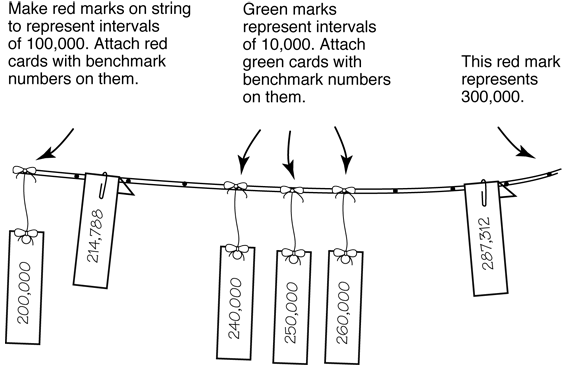News Number Line
Est. Class Sessions: 2Developing the Lesson
Part 1. Represent Benchmarks on a Number Line
Create a Number Line.
Ask students:
Lay one meterstick along the top of the 10-meter paper strip for the number line. Use a red marker to mark each end of the meterstick on the adding machine tape. Label the left mark 0 and the right mark 100,000. Continue labeling the intervals 200,000; 300,000; and so on up to 1,000,000. Have students count along with you.
Tell students these numbers on the number line are called guides or benchmarks. See Figures 1 and 2 and Sample Dialog 1.
Ask:
Use a green marker to mark the intervals of 10,000 as students count, “zero, ten thousand, twenty thousand, thirty thousand … ninety thousand, and one hundred thousand.” Note 100,000 is already marked in red. Ask students to finish marking the 10,000 intervals from 100,000 to 1 million. (See Figure 2.)
If you use Option A or B for your number line, the completed number line should look similar to the one in Figure 3. In Part 2, students will use paper clips to attach each of the news number line index card strips from the Newswire display in the proper place along the number line.
If you use string for the number line, mark the benchmark 100,000 and 10,000 intervals with red and green markers, respectively. Attach red cards (100,000s benchmarks) and green cards (10,000s benchmarks) in their appropriate places. When students attach large numbers to the number line in Part 2, fold a portion of each index card strip from the Newswire display over to form a small flap. Fold the flap over the string and use a paper clip to attach the card to the number line. This should keep the index cards from slipping. See Figure 4.
Connect the Number Line to Big Base-Ten Pieces. Compare the number line to the big base-ten pieces the class created in Lesson 4. Be sure students can reference the Big Base-Ten Pieces they created. They can also refer to the picture of the pieces in Lesson 4 of their Student Guide. Remind students that a megabit (1,000,000) represents the largest number on the number line the class just created.
Ask:

















